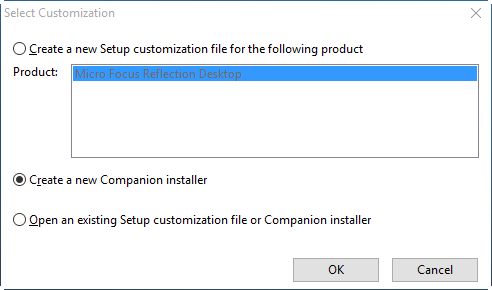8.1.1 Specify Access Using Permissions Manager with the Installation Customization Tool
You can open Permissions Manager from the Installation Customization Tool to lock down access. When you use this approach, the resulting .accessfiles are automatically added to the correct directory in the package (MSI file).
NOTE:These files are not saved to your local machine. They are saved only in your MSI database. To make changes to these files, you will need to use the same approach to edit them as you used to create them. You’ll need to open the MSI file in the Installation Customization Tool and then open Permissions Manager from the tool.
To set user and group access with the Installation Customization Tool
-
From your administrative installation point, open the Installation Customization Tool from a shortcut or by typing the following command line:
<path_to_setup> \setup.exe /admin
-
In the Select Customization dialog box, select Create a new Companion installer.

-
On the left pane, select Specify install locations.

-
Under Installation type, select whether to install the settings to all users of a machine or only for the user who installs it.
NOTE:Only actions.access, application.access, and security.access files can be deployed to all users.
-
In the left pane, select Modify user settings.
NOTE:Under Application - Settings, the Permissions Manager displays groups of configurable items. These items are listed by their internal names, which may not exactly match the user interface item. The item's Accessibilityindicates whether the user can configure the item (Full) or if administrator assistance is required to configure the item (Restricted).
-
In the Make changes to user settings pane, select one of the .access options and click Define.
-
In Permissions Manager, under Groups, select the group of settings you want to control access to (for example, Document\Connection\TN3270Basic).
-
In the Itemsbox, in the Accessibility column for the item (or items) you want to restrict, click Full and then select Restricted from the drop down menu.
NOTE:The Accessibility drop down menu includes three items:
-
Full: All users can configure the item.
-
Restricted: Only administrators of the system can configure the item. These items have the Windows access shield added to their icons.
-
Read-only: No users of the system can configure the item. These items are grayed out.
-
-
Under Additional security options, select how to control session file encryption:
To do this
Select
Configure all sessions so that users can open only encrypted display session files.
User can open only encrypted session files
Configure all sessions so that users can save a display session only if it is encrypted.
User can save only encrypted session files
-
From the Filemenu, choose Save As and save the companion installer package.
If you selected Installs only for the user who installs it when you specified install locations, the companion installer package automatically specifies to deploy this .access file to [AppDataFolder] The full path of the Roaming folder for the current user. The default is C:\Users\username\AppData\Roaming\. \Micro Focus\InfoConnect\Desktop\v17.0.
If you selected Installs to all users of a machine, it specifies to deploy the .access file to [CommonAppDataFolder] The full path to application data for all users. The default is C:\ProgramData. \Micro Focus\InfoConnect\Desktop\v17.0.
NOTE:
-
Make sure to set file access rights on .access files to prevent users from deleting, replacing, or editing them.
-
To deploy files to the [AppDataFolder] The full path of the Roaming folder for the current user. The default is C:\Users\username\AppData\Roaming\. \Micro Focus\InfoConnect\Desktop\v17.0 folder, you will need to use a deployment tool that allows you to install the companion installer package as the user.
-
When accessing a setting via an API, such as executing a macro, a setting with restricted access cannot be modified. (When attempting to set a restricted setting via an API, an error is logged.)
-
Setting session encryption options in an *.access file affects only the associated session type. For example, limiting users to opening only encrypted session files in rd3x.access affects only 3270 terminal session files, and not 5250 session files.